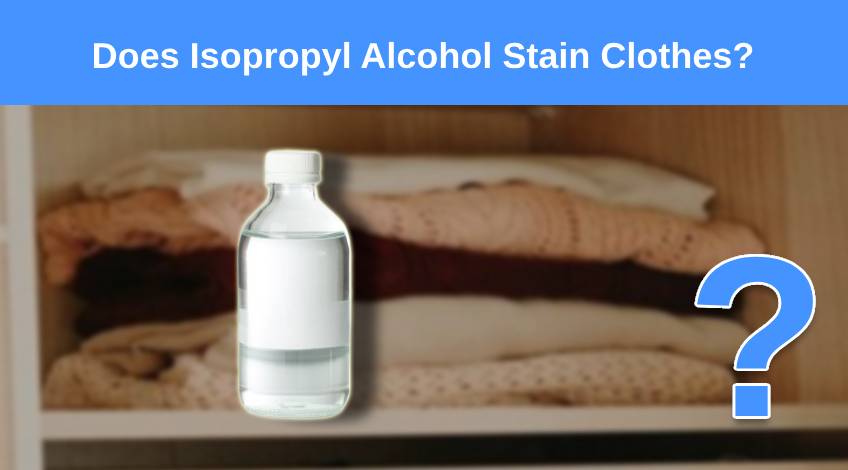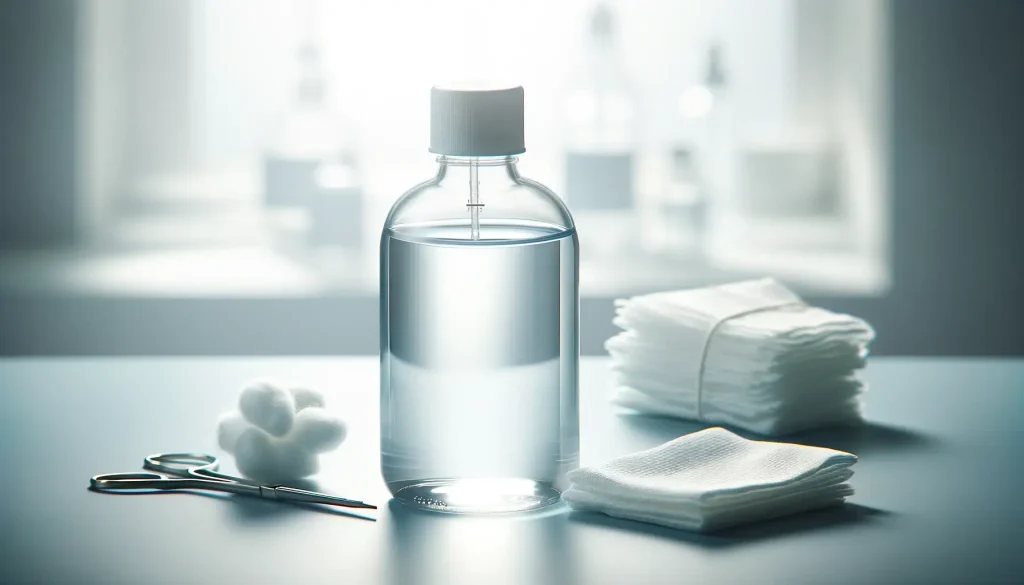
Does Isopropyl Alcohol Stain Clothes?
When we accidentally stain our clothes and we’re outside, our options for treating the stain can be limited. Thankfully, most of us carry isopropyl alcohol with us, as it is popular for treating stains when we don’t have access to running water and soap.
But will it also stain our garments?
To keep it short: no, isopropyl alcohol will not stain clothes, and is an effective stain remover. You should practise caution when using it though, as it can lift the dye on your coloured garments, especially on delicate fabrics.
Let’s learn a bit about isopropyl alcohol and how to use it to treat stains in this article!
What Is Isopropyl Alcohol?
Isopropyl Alcohol is a clear, colourless liquid with a strong odour that is primarily used to kill bacteria, making it a popular tool for sanitation and antiseptic purposes.

Because of its cleaning properties, it is now used by some as a stain remover that can remove oils, greases, and certain inks on clothes. However, since it is not specially formulated for that purpose, many people are worried that it may set stains or even cause staining on their clothes.
As we said earlier, isopropyl alcohol will not leave stains on your garments. However, improper use can cause damage or discolouration, especially when you apply it on delicate or coloured clothing. But how does this happen?
Actually, the isopropyl alcohol’s possible dye-removing properties are more likely to happen in fabrics dyed with cheap or non-fixed dyes. Therefore, the risk of staining is more about the stability of the dye itself, rather than the actual properties of the alcohol.
Just think of it this way, if the dye lifts or migrates in the few minutes that alcohol comes in contact with it (remember that alcohol dries quickly) it is not stable in the first place. It is also possible if you use too much isopropyl alcohol, that you can also damage your clothing in a similar manner.
Hence, proper application is a must when using isopropyl alcohol to prevent discolouration and damage. You want to remove stains, not damage your clothing.
TIP: Isopropyl alcohol is best used for removing ink, makeup, and grease stains!
How To Use Isopropyl Alcohol For Stain Removal
Isopropyl alcohol is an effective agent for removing certain types of stains from clothing, including ink, grass, and oil-based stains.
Now that you know that proper use is the key to avoiding damaging or removing the dyes on your clothing, it’s time to learn how to use isopropyl alcohol the right way.
Here’s a simple, step-by-step guide on how to use it for stain removal:
Step 1: Check the Fabric
Before you start, it’s important to make sure the alcohol won’t damage your fabric.
Find a small, hidden part of the fabric, like the inside seam, and apply a little alcohol. Wait a few minutes to see if there’s any reaction, like a colour change or damage. If the fabric looks fine, you’re good to go!
Step 2: Blot the Stain
When there’s a spill or stain, don’t rub it! Rubbing can make the stain bigger or push it deeper into the fabric.

Instead, gently dab the spot with a clean, dry cloth or paper towel to soak up as much of the spill as possible.
Step 3: Apply Isopropyl Alcohol
Take a clean cloth or a cotton ball and moisten it with isopropyl alcohol.
Tap it gently on the stain, starting from the outside edge and moving towards the centre. This method helps to stop the stain from spreading out. Be gentle to avoid damaging the fabric.
Step 4: Blot Again
After dabbing the stain with alcohol, use a fresh, dry cloth to blot the area again.
This helps to lift the stain out of the fabric. You might need to repeat the application of alcohol and blotting a few times, especially if the stain is stubborn.
Step 5: Rinse the Area
Once the stain appears to be gone, rinse the treated area with cold water.
This helps to remove any remaining alcohol and residue from the stain. Be thorough with rinsing to ensure all the alcohol is washed out, as leaving it in can irritate the skin or damage the fabric over time.
Step 6: Wash as Usual
After rinsing, wash the fabric as you normally would.
Follow the care instructions on the label of the fabric for washing. This can involve machine washing or hand washing, depending on the fabric type. Washing helps to completely remove any leftover stains and alcohol.
Step 7: Air Dry the Fabric
Let the fabric air dry.

Avoid using heat, like a dryer or an iron, directly after treating the stain with alcohol because heat can set the remaining parts of the stain into the fabric, making it harder to remove.
What To Do If Isopropyl Alcohol Lifts The Dye On Your Fabrics
Now, if you applied too much alcohol to your clothes, don’t be surprised to see the dye migrate or lift.
Don’t panic yet, here are some methods you can try:
Use A Dye Fixative
A dye fixative can help set the colour back into the fabric. This is especially useful if the fabric is of a single colour and you just need to restore its uniform appearance.
Follow the instructions on the product label for the best results.
- Suitable for home interiors art works
- Designed for easy usage and storage
Use A Fabric Marker
If the discoloured area is small, you might be able to touch it up with a fabric marker. Choose a marker that closely matches the colour of your fabric.
This method is good for quick, small-scale fixes.
Use A Fabric Dye
If a large area of the fabric has been affected, re-dying the fabric might be necessary.
Choose a dye that matches the original colour as closely as possible. This approach is more time-consuming and may require a complete dyeing process, which includes pre-washing the fabric, dyeing it according to the product instructions, and then washing it again to remove any excess dye.
Are Isopropyl Alcohol And Rubbing Alcohol The Same Thing?
Many of us think that isopropyl alcohol and rubbing alcohol are the same, but there’s actually a small difference.
Rubbing alcohol is a mixture that usually contains about 70% isopropyl alcohol and 30% water. This makes it less strong compared to pure isopropyl alcohol.
Rubbing alcohol is often used for medical purposes, like cleaning skin before an injection, because it’s strong enough to kill germs but diluted enough not to harm your skin.
Tips For Using Isopropyl Alcohol On Clothes
Using isopropyl alcohol on your clothes can be very helpful, especially for stain removal and disinfection. If you’re having lunch outside and you only have alcohol with you, it could be the best option that will save your clothes from potential ruin.
Before we end this article, here are some bonus tips to guide you when using isopropyl alcohol on your fabrics:
- Always do a patch test on a hidden part of the garment to make sure the alcohol won’t damage the fabric or cause the colour to bleed.
- Avoid using isopropyl alcohol on very delicate materials like silk, wool, or leather. These fabrics can be damaged by the alcohol.
- After treating the garment with isopropyl alcohol, wash it according to the care label instructions to ensure proper handling and maintenance.
And there you have it! Now that you know how to use isopropyl alcohol correctly, you can make the most of its benefits for cleaning and maintaining your clothing without risking damage.
Do you have questions? Ask away!
SEE ALSO: How To Remove Ink Stains From Clothes
Frequently Asked Questions
Isopropyl alcohol will not ruin clothes if used properly. However, it can cause damage or discolouration, especially on delicate or coloured garments, if used improperly or in excess.
Yes, isopropyl alcohol can remove ink from clothes. It is particularly effective in treating ink, makeup, and grease stains.
Isopropyl alcohol can discolour dark garments if the dye is not stable or fixed properly, especially if too much alcohol is used or it is applied incorrectly.
Other alternatives to remove stains include using vinegar, bicarbonate of soda, lemon juice, or stain-removing commercial products specifically formulated for treating various types of stains on fabrics.





